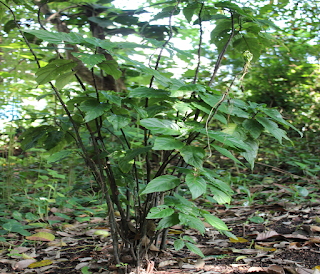Asystasia gangetica
Asystasia gangetica T. Anderson
(This plant is belongs to family Acanthaceae)
(This plant is belongs to family Acanthaceae)
Asystasia gangetica
(Rumput Israel)
(Hidayat T., 2017)
Classification:
Kingdom : Plantae
Divisio : Magnoliophyta
Classis : Magnoliopsida
Order : Scrophulariales
Familia : Acanthaceae
Genus : Asystasia
Species : Asystasia
gangetica
Description:
Asystacia gangetica is an
attractive, fast-growing, spreading, herbaceous groundcover that grows from 300
mm to 600 mm in height. The stems root easily at the nodes. Leaves are simple
and dark green. It produces a cream-coloured flower with tessellated purple
markings on the palate (lower petal of the corolla) in spring and summer. Flowers
are produced over a long period and are followed by capsules with brown seeds.
It is semi-hardy, and young plants require protection in areas of heavy frost.
In tropical areas it can grow rampantly. In nature Asystacia has
developed a good relationship with the honeybee that pollinates the flowers.
The white petals of the flowers and purple blue strip on the lower petal
attract the insect, indicating to the honeybee where to find the nectar. The
flowers also serve as food for beetles and the plant receives visits from ants.
The flowers are very attractive to butterflies too (Lithudzha, 2004).
Spot Character:
Yellowish-white
flowers
Benefit:
Ornamental
Plant
Distribution:
Southeast
Asia, China, Australia, Papua
Location
Status:
Aystasia gangetica is not threatened in any way as is listed as LC (Least Concern) in the Red Data List. According to the Global Invasive Species Database this creeper has caused major problems in the ecosystems of the Pacific Islands. It is potentially highly invasive.
Leaves of Asystacia gangetica
Flower of Asystacia gangetica
REFERENCE
Elliot Litdhudza. (2004). Asystacia gangetica. [Online]. Tersedia: http://pza.sanbi.org/asystasia-gangetica.
Hidayat, T. dan Abdurahman, E. (2017). Keanekaragaman Tumbuhan Biji di Kampus UPI Bandung. Bandung: UPI Press





Komentar
Posting Komentar